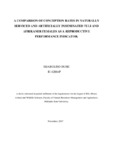Please use this identifier to cite or link to this item:
https://cris.library.msu.ac.zw//handle/11408/3253| Title: | A comparison of conception rates in naturally serviced and artificially inseminated Tuli and Afrikaner females as a reproductive performance indicator. |
| Authors: | Dube, Sijabuliso |
| Keywords: | Indigenous cattle Breeding method Conception rate/pregnancy rate Smallholder farmers. |
| Issue Date: | 2017 |
| Publisher: | Midlands State University |
| Abstract: | A study was conducted to compare conception rate between groups of 71 Tuli and 86 Afrikaner heifers and cows bred using artificial insemination technology and natural service method at Matopos Research Institute. Data on female ID number (ear tag), last calving date, parity, the breed of animal, breeding method (inseminated vs. natural mating) and pregnancy status were recorded. Binary logistic regression and cross tabulations were used for statistical analysis. Breeding method, breed, parity and last calving date were the predictors and pregnancy status was the dependent variable. The overall conception rate was 66.8%. Conception rate between Tuli and Afrikaner breeds, and between cows in different parity and calving interval groups were not significant different. However, the method of breeding animals significantly (P< 0.05) affected conception rate. More females became pregnant when artificial insemination (77.6%) was used compared to natural mating (56.8%). Conception rate was significantly lower in females with calving dates spanning more than one year (72.1%) compared to females with calving dates falling within 365 days (76.6 %). Heifers also showed a lower conception rate of 52.9%. The cows that had calving dates falling within 365days exhibited higher conception rate in both breeding methods. In conclusion, the study confirms that favourable conception rate can be obtained when the Tuli and Afrikaner breeds which are the common breeds in the southern part of Zimbabwe are exposed to artificial insemination technology, they exhibit comparable results to those bred with natural service method. As such, artificial insemination technology can be used as an alternative method of breeding or can be used to complement natural service in indigenous cattle of Zimbabwe. |
| URI: | http://hdl.handle.net/11408/3253 |
| Appears in Collections: | Bsc Animal and Wildlife Sciences Honours Degree |
Files in This Item:
| File | Description | Size | Format | |
|---|---|---|---|---|
| dissertation.pdf | Full Text | 883.26 kB | Adobe PDF |  View/Open |
Items in MSUIR are protected by copyright, with all rights reserved, unless otherwise indicated.



